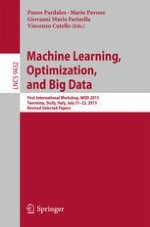2015 | OriginalPaper | Buchkapitel
Semi-Naive Mixture Model for Consensus Clustering
verfasst von : Marco Moltisanti, Giovanni Maria Farinella, Sebastiano Battiato
Erschienen in: Machine Learning, Optimization, and Big Data
Aktivieren Sie unsere intelligente Suche, um passende Fachinhalte oder Patente zu finden.
Wählen Sie Textabschnitte aus um mit Künstlicher Intelligenz passenden Patente zu finden. powered by
Markieren Sie Textabschnitte, um KI-gestützt weitere passende Inhalte zu finden. powered by
